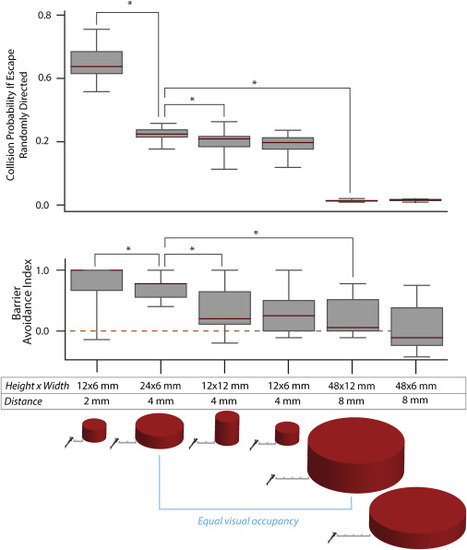Fig. 2
- ID
- ZDB-FIG-230509-29
- Publication
- Zwaka et al., 2022 - Visual object detection biases escape trajectories following acoustic startle in larval zebrafish
- Other Figures
- All Figure Page
- Back to All Figure Page
|
Figure 2. Barrier avoidance depends on barrier size and distance Collision probability is calculated as follows: for each trial within a barrier condition, the heading angle of the fish and the angle to the barrier immediately preceding escape are stored. Each of the 967 trajectories in Figure 1B (no barrier), which reflect the escape behavior of unbiased fish, are then simulated from the stored starting conditions. Intersections between simulated control trajectories and barriers are recorded and divided by the total # of control trajectories to obtain a collision probability per trial. Collision probability therefore reflects how often an unbiased fish would collide with the barriers that subjects encountered during the different barrier conditions. Barrier avoidance decreases in concert with collision probability. The avoidance is also significantly different for barriers with the same retinal occupancy but different distance (blue line) (N = 22, 17, 16, 13, 12, 7; n = 128, 150, 148, 122, 104, 56). Scale bar ticks in diagram, 2 mm. See Figure S3 for a comparison of angle of approach in the shared visual occupancy conditions that suggests a very similar visual input. Mann-Whitney U results: collisions, conditions 1 and 2, p = 2.5e−7; conditions 2 and 3, p = 0.014; conditions 2–5, p = 8.7e−6; BAI, conditions 1 and 2, p = 0.047; conditions 2 and 3, p = 0.009; conditions 2–5, p = 8.1e−4. In boxplots, medians are indicated in red and boxes indicate the interquartile range. See also Figure S3. |

